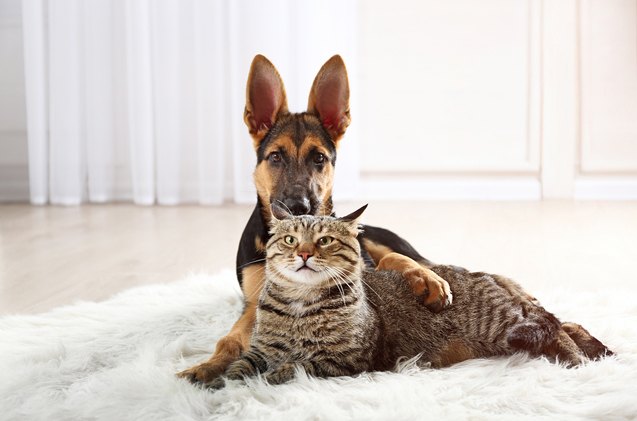How to Introduce Your Cat to a New Dog


Cats and dogs can get along with one another in the same household, but a big part of their ability to establish a friendly relationship lies in proper introductions. So if you currently have a kitty in your family but you’d like to add a canine companion to the mix, check out the tips below to ensure the introduction goes as smoothly as possible and your pets will have the best shot at becoming fast friends.
Consider Personalities
It’s easy to walk into an animal shelter and fall in love with all of the dogs, and one very special canine may end up catching your eye. But before you choose to adopt him and bring him home, consider his personality, as well as the personality of your kitty.
For example, has this particular pooch been exposed to other types of pets, including cats? Does he get along well with other animals? Also, some dogs may play aggressively and may inadvertently injure your cat, while other dogs might lunge, bark, or growl whenever they see cats.
Different breeds will have different dispositions, so that’s a good place to start as you search for a dog who will get along with your cat, but remember that every dog is an individual. Talking to an adoption counselor at an animal shelter and spending time getting to know a dog beyond just falling for his appearance will help you find a companion that will match your kitty’s temperament and create the least amount of stress.
Related: How To Introduce A New Cat To Your Feline Family
The Big Reveal: Sniffing Each Other Out
After you’ve found a dog or puppy that has the highest chances of getting along well with your resident feline, it’s time to prepare for their very first meeting at home. The process is similar to what you’d follow if you were to introduce a new cat into your feline family.
Over the course of a few days, rotate your dog and cat so that one is confined in a single, spacious room with what he needs and the other has freedom to explore. This will allow the animals to be introduced to each other’s scent. You can, for example, put the dog in a crate or in a room while your cat investigates the dog’s scent.
Your dog might end up barking or digging at the separation barrier to try to get at your cat. If this behavior doesn’t subside after a couple of days, consider working with a dog trainer who may help prevent mishaps before they happen.
Related: Tips for Preparing Your Cat for a New Baby
Graduating to the Leash
Once your pets are calm around one another in their confined spaces, you can let both of them be in the same room at the same time, with the dog on a secure leash.
Your cat may hiss and appear frightened, and the dog may be really curious about your kitty or attempt to play. Notice the behavior of each and keep up with this form of introduction until the dog becomes calm enough that he no longer really cares that the cat is even there. Also make sure that your cat is calm, using the litter box, and eating normally. Then you can take your dog off the leash.
In the event that the animals are displaying any aggression or fear, go back to the first step. You’ll need to be really patient and continue this process until both of your pets are relaxed and happy around one another in the same space.
Even at this point in the introduction process, it’s a good idea to keep the animals confined away from one another when they can’t be supervised, especially when you aren’t home.
Unsupervised Meetings
Provided that both animals are calm when your dog is on a leash and then off the leash, you can finally move on to unsupervised meetings. It might take around a month for your pets to positively interact without any fear of harm before you can allow them to be together freely.
The goal is to get your resident cat to accept your new dog, and for your new dog to behave calmly towards your cat. If your dog is overly focused on the cat or shows signs of aggression towards your cat, or if your cat is aggressive towards a calm dog, this might not be a good match and it may not work without a trainer. Also, some cats will never accept a dog in the family, so you need to consider your pet’s needs, especially if your kitty stops drinking, eating, using the litter box, or spending time with the family. Again, working with an animal behaviorist can help if your pets aren’t adjusting appropriately.

Lisa Selvaggio is a freelance writer and editor, and our resident cats-pert, with certifications in pet nutrition and pet first aid. She enjoys producing content that helps people understand animals better so they can give their pets a safe and happy home.
More by Lisa Selvaggio























